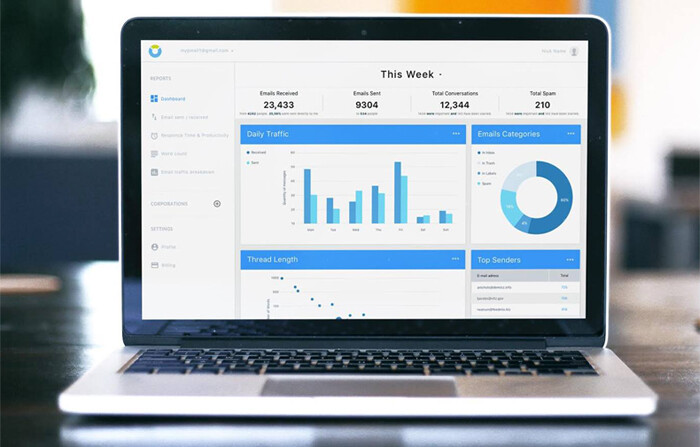Big data is changing the nature of email marketing. Although data analytics has played a vital role in split-testing campaign variables, there are other benefits as well.
One way that big data is helping in email marketing is improving team collaboration. New tools have made it easier for teams to coordinate with each other on their email marketing strategies.
New Tools Rely on Big Data to Boost Email Marketing Performance
Everyone seems to be on a never-ending quest to boost their productivity. Big data has led to the development of new tools that have made it easier than ever.
It makes perfect sense why; being more productive means getting more done in less time, which, depending on your goals, could mean earning yourself a raise, pushing your business to new heights of success, or just having more free time for yourself.
The trouble is, there?s no hack or shortcut to make you instantly more productive (though little tweaks in your daily routine, like consuming caffeine, can help). Instead, if you want to improve your productivity, you?ll need to dig into the elements of your workday, evaluate your current efforts, and focus on key areas of improvement. Your first stop in this journey should be examining your email habits; they?re more impactful than you probably realize.
Email productivity is intrinsically linked to your productivity as a whole, and studying your email metrics using email metrics tools is the only way to make improvements.
Fortunately, new advances in big data have led to new tools that make remote collaboration easier. It is also easier for marketers to share data through cloud storage.
But why is email productivity such a sticking point?
- Communicative effectiveness. Email is the primary mode of communication for most professionals, and how you communicate can have a massive impact on your workload and effectiveness. If you miscommunicate, it could lead to an error that creates much more work for you in the long run. If you misinterpret, you could lose a deal or compromise a client relationship.
- Time spent (and audience impact). Email is a time hog, for you and everyone you connect with. It takes time to draft a message. It takes time to read a message. Even getting a notification tends to pull you away from whatever you were focusing on before?and distractions have much more disruption potential than they typically get credit for. A subtle improvement in your own habits could lead to massive time savings, both for you and the people you interact with.
- Workload and scheduling. Your email habits can tell you a lot about your workload and regular schedule. For example, your busiest email days and times can tell you about the ebb and flow of incoming requests, or alert you to a pain point that needs to be addressed.
- Volume. Every problem in your email productivity is instantly magnified, due to the sheer volume of emails you?re likely handling. The average professional receives 121 emails a day, which means even a loss of 1 minute per email could accumulate to a 2-hour-per-day loss.
The Best Email Metrics Tools for Email Productivity
Getting data on your email habits is a prerequisite to improving your email productivity, but even popular platforms like Gmail don?t offer built-in solutions for measuring your productivity. Thankfully, there are some amazing third-party tools that use the best big data capabilities to help you better understand how you email on a regular basis:
1. EmailAnalytics.

First, there?s EmailAnalytics. This email productivity tool for Gmail digs into your email metrics and assembles them into interactive, easy-to-understand charts and graphs. With it, you?ll be able to learn interesting points related to your email habits, including how many emails you send, how many emails you have in each of several categories, who?s emailing you the most, who you?re emailing the most, your busiest days and times throughout the week, and the lengths of each of your email threads. You can even use the tool with all your employees, so you can track their habits along with yours. Over time, as you start polishing your email habits, you?ll see these metrics improve?and possibly identify new areas to work on.
2. MyAnalytics.
is a tool designed for Office 365, including Outlook. This email productivity tool keeps an eye on how much time you?re spending at work, integrating data from your emails, your calendar, and your usage of other apps. At the end of each week, you?ll see a breakdown of how you?ve spent your time, which you can use to identify instances of time waste?or apps that aren?t providing you a return on your investment.
3. Yesware.
is an email productivity app targeted toward salespeople, though it could feasibly be used by any professional invested in their email habits. It integrates with SalesForce, and allows you to track email open and reply rates, attachment downloads, link clicks, and other valuable information for evaluating your approach to sales. It?s a fantastic email metrics tool for perfecting your sales approach, but may not be as valuable for reflecting on your internal communications.
Making an Action Plan
Seeing your habits displayed in a graph or chart can be illuminating, but data visualization alone can?t make you a more efficient emailer (or a more productive professional). You?ll need to form conclusions about your email habits, and resolve to make positive changes in your approach if you want to see a real improvement. Only an action-based strategy is going to get results.
With that said, action begins with knowledge, and these email metrics tools can give you that knowledge to jump-start your team?s productivity.
Big Data Plays Vital Role in Streamlining Email Marketing
Big data is making email marketing more effective than ever. You can use data analytics to work closely with other members of your team to get the best results.